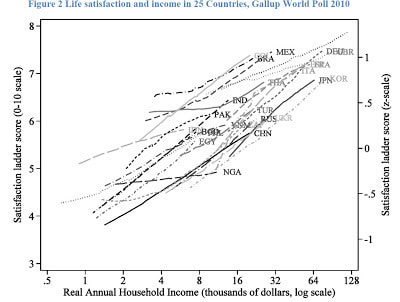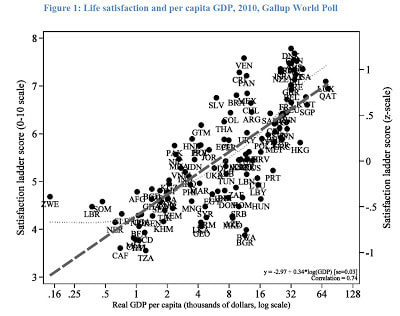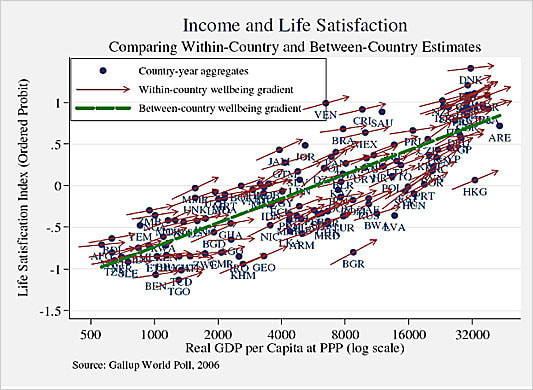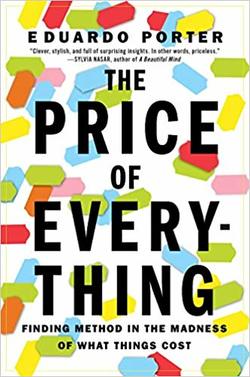|
Sometimes, something is said -- and without validation, it just becomes widely accepted as fact. For example, variations of, "Money can't buy happiness." Or, "Beyond [arbitrary number of dollars], money doesn't increase happiness." Or, for the truly wedged, "Kids who live on dirt floors and have nothing are just so happy." (If you really think that, you are wrong, and seriously need to check your privilege.)
But, as economists Sacks, Stevenson and Wolfers found in The New Stylized Facts about Income and Subjective Well-Being (2012), this is simply untrue. Whether you're looking at individual or national happiness, more money makes people happier -- especially if you look at the data on a log scale.
Recall from your long-forgotten required math classes that there are two main reasons to use logarithmic scales in charts and graphs: 1. To respond to skewness towards large values -- for example, data sets with one or a few points that are much larger than the bulk of the data. (The Richter magnitude scale, which is used for measuring earthquake strength, uses a log scale to span the wide range of possible values -- each step represents a ten-fold increase of magnitude.) 2. To show percent change or multiplicative factors. According to Sacks et al., social scientists who look at changes in happiness vs. increases in an amount of money, rather than a percent of money, aren't getting the full story. In other words, of course looking at raises in income by an amount, rather than a percent, doesn't make people happier. It's called “diminishing returns.” There's a lot you can buy with $22,000 that you couldn't buy with $20,000. But what can you buy with $102,000 that you couldn't buy with $100,000? But... $120,000 may open doors that $100,000 wouldn't. I previously discussed these findings in "The Great Affluence Fallacy" is a Great Big Lie, but since most people don't know what the "Great Affluence Fallacy" is I thought the information could use a little repackaging. So, without further ado: 1. Wherever you live in the world, rich people are happier than poor people.
For those who prefer words over visuals: all the lines in this figure, which uses a log scale to plot life satisfaction and real annual household income, are roughly parallel. Meaning that an X% raise in income will make you roughly the same amount happier, no matter where in the world you live.
2. Countries with higher GDPs are much happier than countries with lower ones: Again, note the log scale. 3. Rich countries are happier than poor countries… in roughly equal measure to rich people being happier than poor people within a society.
This graph... is an eye-full. Basically, the arrows show the difference in happiness between rich and poor people within a country. The slope of each arrow indicates how much happier (again, on a log scale) rich people are than poor people.
For the most part, the arrows are pretty parallel -- both to each other, and to the between-country wellbeing gradient (the green line). Because rich countries are happier than poor ones, in roughly equal proportion to rich people being happier than poor people. *** Crazy, right? Now, before we move on, let's just address the biggest white privilege (yeah, I often find that term cringe-y -- but in this case, there is no other way to put it) bullshit belief of all time: That kids who live on dirt floors and "have nothing" are sooooo happy, and wouldn't it be great if we could all just be so happy as they are. As I wrote in a previous post on the topic: Are people with dirt floors really happier? Do they really have everything they need? No. Dirt floors suck. Kids who live in homes with dirt floors are exposed to fecal matter, worms, protozoa and other parasites. This leads to diarrhea (which kills 75,000 children worldwide every year), anemia, malnutrition, dehydration, cognitive disorders and developmental disabilities. Which is why, in 2000, Enrique Martínez y Martínez, the governor of the Mexican state of Coahuila, launched a program to replace dirt floors with cement ones. The program, called Piso Firme (Solid Floor), provided more than 34,000 homes with 50 square meters of flooring, at a cost of about $150 per family. (For reference, that was about 1.5 months salary for many residents.) Families were given advance warning so they could prepare their homes. Then the trucks came and poured the cement, and families smoothed it down. Doesn't this look way nicer and cleaner than a dirt floor? But it didn't just look nice. A year later, researchers returned to Coahuila, as well as neighboring Gómez Palacio, which is just across the state line in Durango. They brought scales and medical testing equipment to weigh and measure the children, as well as check for anemia and collect stool samples. The researchers also gave cognitive tasks, asking mothers questions about their babies' ability to recognize words, and asking older kids questions about pictures. And guess what? According to economist Eduardo Porter, author of The Price of Everything: Finding Method in the Madness of What Things Cost: Paving floors led to a 78% drop in parasitic infections. Diarrhea went down 50%. Anemia was down 80%. Kids with cement floors did 30-100% better on cognitive tests than kids who lived in dirt. And! The moms were happier. Depression fell by half, and stress levels decreased drastically. Moms with new cement floors were 70% more satisfied with lives. For $150 per family, Coahuila bought a lot of happiness, health and life satisfaction. Which is why Piso Firme was adopted by the rest of Mexico soon after. So please. If you don't want to look like a rich, white asshole, STOP saying that kids who live on dirt floors are happy. They aren't, and neither are their parents.
Want to know more WAY cool stuff? Check out the rest of Eduardo Porter's The Price of Everything: Finding Method in the Madness of What Things Cost.
*** So, yes. Paved floors are absolutely one way to buy happiness. But, despite money's ability to make us happy, most people are terrible at spending money in ways that make them happy. Anti-social spending is a recipe for disaster. Which is not the same as saying money can't buy happiness. After all, as I wrote in Money DOES Buy Happiness -- IF You Know How to Spend It, there are, in fact, two proven ways to buy happiness: 1) Spending money on someone else. 2) Spending money on experiences, rather than possessions. The first point was demonstrated by Dunn, Akin and Norton in their 2008 paper, Spending Money on Others Promotes Happiness. The study, which appeared in Science, found that spending as little as $5 on someone other than yourself increases your happiness. They gathered their data by setting up experiments across the globe, in which participants were given some amount of money (ranging from $5-$20) and telling them to either spend it on themselves or spend it on someone else. Then, at the end of the day, participants completed a questionnaire that measured their mood and happiness -- as well as how they spent the money. Norton et al. found that the amount of money given to participants (to spend on either themselves or on others) had little impact on mood or happiness. Instead, the relative percentage of the money that they spent on others predicted happiness. The experiments have been replicated across the globe, from Canada to Uganda. (Which is kind of a big deal, since the social sciences are facing a little bit of a replication crisis right now.) Whether participants used their money to help a friend pay for a lifesaving malaria treatment or to buy a movie ticket or a coffee for a friend, they experienced similar boosts in their mood. The result held true across three different studies: a nationally representative survey, a field study of windfall spending, and an exploration that randomly assigned participants to spend money on others or themselves. In other words, you don't need to make a huge donation or buy an expensive gift to feel the benefits of prosocial spending. Small changes in spending habits can produce big boosts in your mood. To learn more about Dunn and Horton's research, check out their book, Happy Money: The Science of Happier Spending -- even though it's about science research, it's a really fun, funny and insightful read: Now let's discuss that second point: that experiences make us happy, and possessions... don't, really. We've all heard the story about the guy who bought a fancy car but still felt sad. This doesn't mean a car can't make you happy. If you love driving, if you are passionate about speed and specs and vehicle performance, a car can make you happier. Because in your hands, it's not a thing. It's an experience. It's a tool. It's something that makes your heart race. Because experiences matter way more than things. According to Happy Money: The Science of Happier Spending, here are a few of the reasons why: 1. Anticipation of an experience drives happiness -- whereas anticipation of a possession drives impatience. Think of Black Friday vs. getting ready for a party with your friends. 2. Experiences tend to be social. Possessions tend to be... well, possessions. Humans are social beings. We love stories. We love moving our bodies together. We love sharing values and ideas. Possessions, on the other hand, get old quickly. They can't relive a moment with us. They can't make us laugh. They can't bring us soup when we're sick. 3. Most people stop appreciating things over time. This is actually part of the reason why raises are such terrible motivators. A raise is only a raise for a week. After that, it's just your salary. It's because we evolved to never be content with the things we have -- hoarders do much better in famines than people who were happy with the things they had. 4. We're less likely to measure the value of experiences by comparing them to those of others. This point may be less true now than it was when Happy Money was published, as photo sharing and social media have become ubiquitous. I used to advise people to leave their phones at home when they traveled -- now, I wouldn't dream of it. Having a mobile device is just way too convenient. But this also means that, even while I'm on my amazing Philippines vacation, swimming with dugongs and having the best time ever: I can still go back to my hotel that night and see my cool friend Becca's epic photos from Jordan.
NOT Becca's photo -- hers were actually 100 times cooler than this. :P
So... what can you do about that? I mean, whoever you are, limiting or reducing your screen time is basically a guaranteed way to increase your happiness and decrease your risk of depression. Especially if you're someone who tends to ruminate over other people's travel photos or feel FOMO while you're at a party on a Friday night. In fact, scholarly research has found that FoMO is robustly associated with social media engagement (b = .40, p < .001). Other strategies for keeping our focus on your experience, rather than trying to compare it to others:
A third way to use money to buy happiness is to buy conveniences and stress reducers. I love working with my hands, and will always repair things myself if I can... but there is definitely something to the old adage I learned in boarding school (from a dormmate who proudly "didn't know how to work a broom"): "Why do something yourself that you could pay someone to do for you?" No, but seriously. Why would you wash your dishes by hand, when you could just buy a dishwasher? Why would you clean your house yourself, even though you really don't have time to, and even though it aggravates your carpal tunnel? Why would you spend your evening cooking, when you hate cooking and can afford takeout? I've long supported the idea of hiring people to help around the house (I probably wouldn't even choose to have kids if I couldn't afford a night nurse), and love Londa Schiebinger's work that shows the equalizing effects of universities and businesses offering housework as an employee benefit. But now, science research shows that maids and takeout joints actually improve our happiness. In Buying time promotes happiness, Whillans, Dunn, Smeets, Bekkers, and Norton used surveys of large, diverse samples from four countries to reveal that spending money on time-saving services is linked to greater life satisfaction. They established causality, they showed that working adults reported greater happiness after spending money on a time-saving purchase than on a material purchase. Cool, right? Long story short, there is a very interesting relationship between money and happiness -- so even though it "feels good" or whatever to pretend money doesn't buy happiness, it's worth digging a little deeper to see what the research actually says, and how you can use it to improve your own life. Broke? Check out How to Have Fun Every Day -- WITHOUT Spending Much Money.
3 Comments
Zane
6/24/2018 04:47:41 am
I love deepities. It's always fun to discover new ones. I'll add "Money can't buy happiness" to my list.
Reply
Lex
7/7/2018 11:37:20 am
I love this post. Money spent well is conducive to happiness. As you say, many people simply don't spend it well.
Reply
Leave a Reply. |
About the Author

Eva is a content specialist with a passion for play, travel... and a little bit of girl power. Read more >
Want to support The Happy Talent? CLICK HERE!
Or Find me on Patreon!
What's Popular on The Happy Talent:
Trending in Dating and Relationships:
What's Popular in Science: Playfulness and Leisure Skills:
Popular in Psychology and Social Skills:
Categories
All
|


































 RSS Feed
RSS Feed